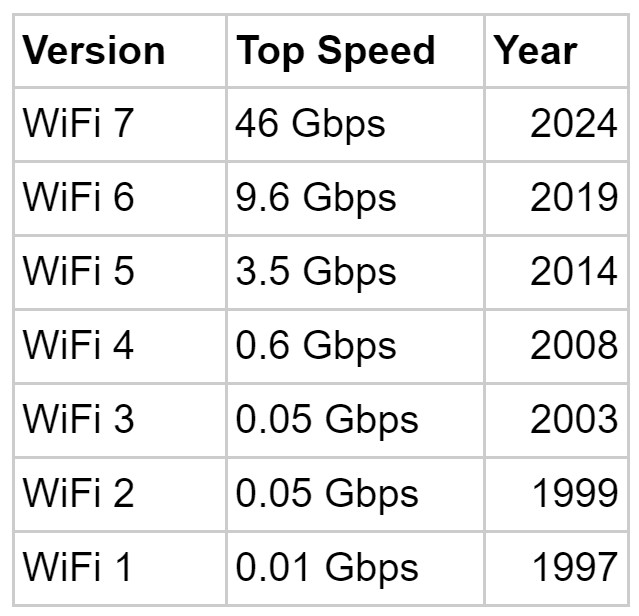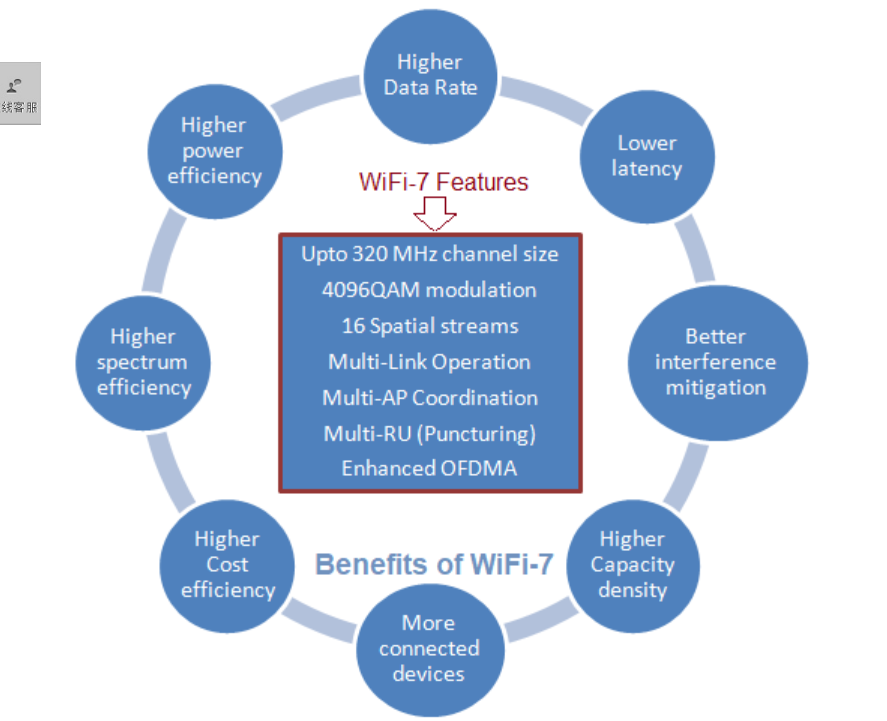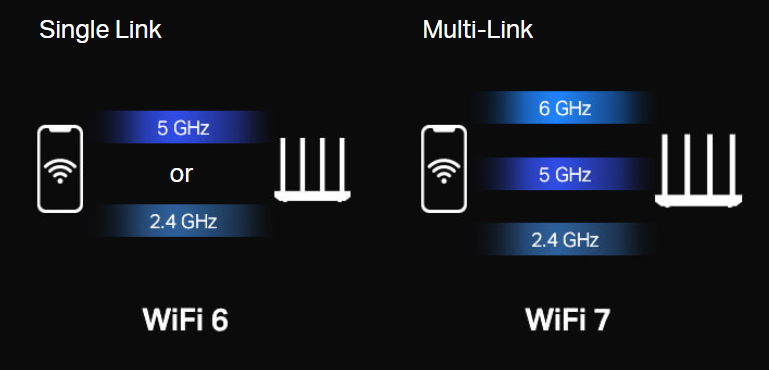

Short-range wireless communication technologies include Wi-Fi, ZigBee, Bluetooth, and Z-Wave that we are familiar with. Today we will unveil the mystery of Wi-Fi.
Foreword introduction
Over the past 20 years, Wi-Fi has been carrying ever-increasing network demands with only two frequency bands of 2.4GHz and 5GHz. According to ABI Research, Wi-Fi upload traffic will surge by 80% in 2022, and Wi-Fi data traffic has surpassed cellular traffic, making it the access method that contributes the most to traffic growth.
With the increasing number of ultra-high-throughput and low-latency applications, research is intensifying on the seventh generation of Wi-Fi technology (Wi-Fi 7), also known as IEEE 802.11be. With extremely high throughput, Wi-Fi 7 is designed to provide devices with faster and more efficient wireless connections, allowing data transmission to enter a new era of Wi-Fi 7.
Content Express here

802.11
Released: 1997
Defines the Carrier Sense Multiple Access Protocol with Collision Avoidance (CSMA/CA) protocol and compatible interconnection of data communication devices in a Local Area Network (LAN).
802.11b
Released: 1999
Alias: Wi-Fi 1 (first generation Wi-Fi)
The theoretical maximum data rate of 802.11b is 11 Mbps, using the original standard CSMA/CA media access technology, the throughput is improved, and the price is significantly reduced. 802.11b is widely accepted as a wireless LAN protocol.
802.11a
Released: 1999
Another name: Wi-Fi 2 (second generation Wi-Fi)
The IEEE 802.11a standard uses the same core protocol as the original standard, but at a higher frequency (5 GHz), it has a theoretical data rate of 54Mbps, and other data rates are 6 Mbps, 9 Mbps, 12 Mbps, 18 Mbps, 24 Mbps, 36 Mbps and 48 Mbps. But it cannot interoperate with 802.11b because it operates in a different unlicensed ISM band.
802.11g
Released: 2003
Another name: Wi-Fi 3 (third generation Wi-Fi)
802.11g also has a theoretical throughput of 54 Mbps. It is the successor to the popular 802.11b specification, which has a maximum throughput of 11 Mbps. Both use the 2.4 GHz band, but 802.11g uses OFDM. 802.11g is backward compatible and Supports 802.11b and 802.11g clients.
802.11n
Released: 2009
Another name: Wi-Fi 4 (fourth generation Wi-Fi)
802.11n is the next IEEE 802.11 standard after 802.11a, 802.11b, and 802.11g. As a supplement to the 802.11 series of standards. 8021.11n uses a technique called Multiple Input/Multiple Output (MIMO) and wider radio frequency channels, also provides a mechanism called "Frame Aggregation" to reduce the time between transmissions, backwards compatible with 802.11b/g equipment.
802.11ac
Released: 2014
Another name: Wi-Fi 5 (the fifth generation of Wi-Fi)
With a theoretical maximum speed of 1300 Mbps (1.3 Gbps) - 2300 Mbps (2.3 Gbps), 802.11ac builds on what 802.11n offers to increase throughput, bandwidth and speed.
The advent of Wi-Fi 6
802.11ax
Published: 2019
Another name: Wi-Fi 6 (the sixth generation of Wi-Fi)
IEEE 802.11ax is the sixth generation of Wi-Fi, building on the strengths of 802.11ac. It provides higher wireless capacity and reliability by using denser modulation schemes, smaller subcarrier spacing, and scheduling-based resource allocation. 802.11ax is a dual-band technology that operates in the 2.4 GHz and 5 GHz bands, providing speed upgrades even for the lower bands for maximum compatibility with 802.11a/b/g/n/ac clients.
This article is part of:
is Now the Time to Replace Your WiFi 6 Router?
Which also includes:
Explore YOUR free trial - AT CDEBYTE Experience a World of Possibilities with Our Free Trial of 1000+ LoRa/Wi-Fi/ ZigBee/BLE Modules! |
The advent of Wi-Fi 7
802.11be
Release date: 2024 (to be released)
Another name: Wi-Fi 7 (the seventh generation of Wi-Fi)
Wi-Fi 7 is the latest Wi-Fi technology for routers and modems that is four times faster than Wi-Fi 6. This massive throughput supports virtual reality (VR), low-latency gaming, and higher-quality streaming. While it will change the way you use the web, it won't be fully available until 2024. Certified Wi-Fi 7 devices are not expected to be common in the market until 2025.
With speeds of up to 46 Gbps, Wi-Fi 7 will connect more devices to a single router, each using enormous throughput and quadrature amplitude modulation (QAM) for more efficient wireless connections.
Refer article :Why do we need Wi-Fi 7? An Overview of Wi-Fi 7
How is Wi-Fi 7 different from Wi-Fi 6?
Wi-Fi 7 is much faster than the Wi-Fi 6 used today, and more data is piped to more devices, all without compromising each other's experience. When you want to watch a game upstairs while your partner streams a movie in the den and the kids play "Star Wars" in a VR headset in the bedroom, you'll also have these simultaneous operations without any buffering issues.
The diagram below is a timeline of the different standards for Wi-Fi since 1997, shared by the Wi-Fi Alliance:

Specific advantages and features of Wi-Fi 7
① faster
It's hard to imagine Wi-Fi 7 having such a dramatic speed upgrade. Because theoretically speaking, the quadruple speed jump from a top speed of 9.6 Gbps to 46 Gbps is extreme. Secondly, the current Wi-Fi6 is relatively able to meet the current transmission needs, why would such a high-speed version of wireless technology be launched?
The table below shows the speed difference between Wi-Fi 6 (2019) and Wi-Fi 7 (2024). This extra speed will open up entirely new ways to use the internet. For example, you can virtually try on a pair of shoes or glasses, and it will give you a "real feel" of trying it on, so that you will save a lot of time and money during the shopping process.

② Lower latency
Compared to Wi-Fi 6, Wi-Fi 7 has much lower latency. While quadrupling the speed is a big leap, the increased speed has a big domino effect on latency, the kind of lag you experience when conferencing, gaming, and streaming. According to Microsoft, you'll see 100x lower latency in general, and 15x lower latency in VR, which drastically reduces loading and buffering times.
The dramatic drop in latency has far-reaching practical applications to create incredibly immersive web experiences. Wi-Fi 7's wider 320 MHz channels and unlicensed 6 GHz band will give you richer (and less glitchy) real-world gaming, remote work, healthcare, and education experiences than you're used to now.

③Multi-link function
While Wi-Fi 6 can serve multiple devices such as laptops, phones, and tablets at the same time, and this signal sharing is convenient, it creates latency issues. In this regard, Wi-Fi 7 is obviously better. That's because Wi-Fi 6 uses MU-MIMO technology, which supports up to four devices at a time. MU-MIMO technology splits a single signal into smaller signals, which means multiple devices share the same signal.
In contrast, Wi-Fi 7 uses multi-link operation, with multiple signals to support multiple devices. Therefore, Wi-Fi 7 routers will prioritize unused channels. As you add more and more devices to the network, wireless routers fall back to MU-MIMO technology to share channels.
④ Higher data transmission quality
Wi-Fi 6 relies on 1024-QAM to use radio signals more efficiently to send and receive more data. This 1K QAM architecture makes Wi-Fi 6 25% faster than Wi-Fi 5. In a massive upgrade, Wi-Fi 7 uses 4K QAM, which is four times faster than Wi-Fi 6E.
As a Wi-Fi 7 modem user, the higher QAM isn't a perk for you, but the "reason" behind the standard's faster speeds.
Future Predictions for Wi-Fi
Omdia once stated in the 2023 LTE/5G private network related trend observation, "In the private network field, 2023 will be a year of vigorous development of Wi-Fi 6 (not 5G), 40% of enterprises choose or consider Use Wi-Fi instead of a private network, far exceeding public cellular networks. Wi-Fi 6 will not completely replace 5G, but will only replace specific scenarios. In the 5G era, the competition of Wi-Fi 6 in the private network field is obvious, and the competition of Wi-Fi 7 (expected to be released by the end of 2024) to 6G (expected around 2030) will continue.
The Wi-Fi Alliance predicts that billions of people and 18 billion devices worldwide will rely on Wi-Fi connections to connect to the Internet in 2024, and the shipment of Wi-Fi devices will increase to 4 billion units per year. The actual implementation of Wi-Fi worldwide is related to ITU's spectrum allocation and local spectrum policies.
Wi-Fi has two frequency bands, 2.4GHz and 5GHz, but the unlicensed spectrum in these two frequency bands is limited and crowded. Some countries and regions have begun to extend the Wi-Fi frequency band to 6GHz, which can provide larger bandwidth and faster speed and more capacity. Wi-Fi 7 requires 320MHz continuous channel support, and there is an urgent need to expand the range of frequency bands. However, countries have different attitudes towards whether to use the 6GHz frequency band as an unlicensed frequency band to allow Wi-Fi access. The United States, Canada, South Korea and other places have made it clear that all 6GHz frequency bands can be used by Wi-Fi; the European Union, Russia and other places have used the 6GHz frequency band in segments; China, Asia and parts of Africa have not yet clarified the 6GHz allocation policy.
China is currently leading the world in 5G development, and 5G and 6G development are also seeking more support for spectrum resources. Spectrum resources are scarce. It is not clear whether Wi-Fi 7 will be supported by the 6GHz frequency band for domestic large-scale commercial use in the future. -The synergistic relationship between WiFi 7 and 5G/6G is particularly important.
Continue Reading About 5G:
5G and IoT device upgrades require OTA platforms
Focus on 5G Green and Low-Carbon Development: How to Take the "Double-Carbon" Road for Operators
What technological innovations are needed for 5G and WiFi 6E networks
How can 5GRedCap replace Cat.4 and Cat.1
- Introducing 11 Common IoT Wireless Communication Protocols: How to Choose the Best Protocol
- 4 Technologies Learn How LPWAN Enables Communication Between IoT Devices
- How USB2.0 device establishes connection with the host
- RS232/RS485 serial port communication introduction
- Detailed explanation of SPI communication protocol
- Introducing LoRa stable diffusion: based on LoRa communication
- Communication protocol: ModBus RTU protocol and ModBus TCP protocol








